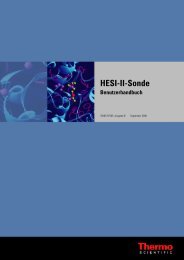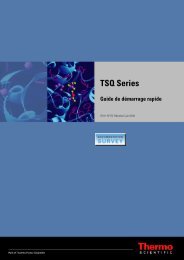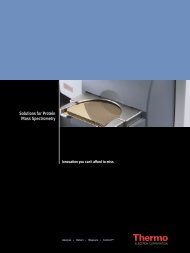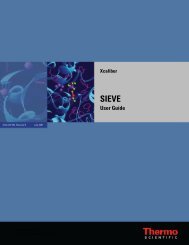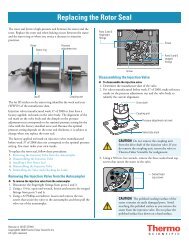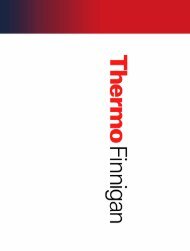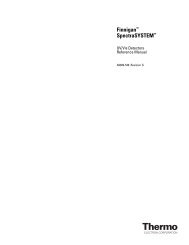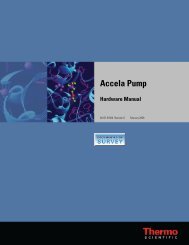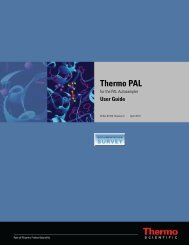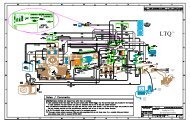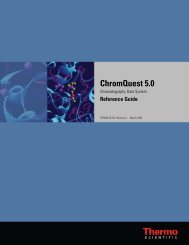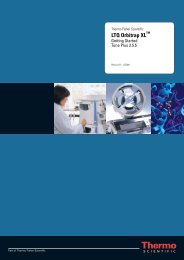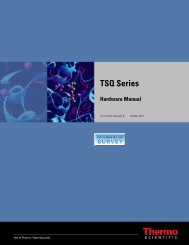WideBand Activation™ Technology
WideBand Activation™ Technology
WideBand Activation™ Technology
Create successful ePaper yourself
Turn your PDF publications into a flip-book with our unique Google optimized e-Paper software.
m a s s s p e c t r o m e t r y<br />
PSB 102<br />
Page 1 of 2<br />
Part of Thermo Fisher Scientific<br />
P R O D U C T S U P P O R T B U L L E T I N<br />
<strong>WideBand</strong> Activation <strong>Technology</strong><br />
The resonance excitation process used for MSn in an ion trap device fragments only the<br />
selected ion. Fragment ions formed in this manner do not themselves undergo subsequent<br />
fragmentation, as is the case in the collision cell of a triple quadrupole or QqToF mass<br />
spectrometer. This has obvious benefit because fragmentation pathways are significantly<br />
easier to follow using an ion trap device.<br />
Hydroxylated compounds, however,<br />
frequently show only the loss of H2O in the<br />
first stage of MSn analysis. In this situation,<br />
an additional stage of MS would be required<br />
to generate more structurally useful<br />
information.<br />
To overcome this limitation, the<br />
Thermo Scientific LTQ and LCQTM series of<br />
instruments include <strong>WideBand</strong> Activation<br />
as a standard feature. For the first time in a<br />
commercial mass spectrometer the isolation<br />
and activation widths of the MSn process are<br />
effectively decoupled.<br />
<strong>WideBand</strong> Activation operates by<br />
applying resonance excitation energy over a<br />
mass range which extends to 20µ lower than<br />
the selected ion. This ensures that both the parent ion and any subsequent water loss ion<br />
will undergo fragmentation while retaining the specificity of the unit mass isolation of the<br />
parent ion.<br />
In qualitative applications,<strong>WideBand</strong> Activation is advantageous because an<br />
additional stage of MS is not required to generate useful structural information. This<br />
is particularly relevant when conducting Data Dependent(1) experiments. Without<br />
<strong>WideBand</strong> Activation additional MS3 scans might be necessary which reduce the number<br />
of different co-eluting components that can be analyzed under a chromatographic peak.<br />
In quantitative experiments, the loss of water provides no greater specificity than<br />
monitoring the parent ion by MS only. Additionally, using MS3 for quantitation will result<br />
both in longer scan cycles than MS2 Figure 1<br />
, and will reduce the number of data points taken<br />
across a peak. Having fewer points will lead to less precision in the quantitative data.<br />
<strong>WideBand</strong> Activation eliminates both problems for these experiments–providing the<br />
specificity required and maintaining an appropriate scan cycle time
Page 2 of 2<br />
<strong>WideBand</strong> Activation <strong>Technology</strong><br />
Figure 2 shows the MS 2 spectrum of Labetalol acquired with and without <strong>WideBand</strong><br />
Activation. Standard activation conditions, even with high collision energy, show only the<br />
water loss ion. <strong>WideBand</strong> Activation, in contrast, requires low energy to generate meaningful<br />
fragmentation data.<br />
An additional benefit of this process is that library searchable MS 2 spectra are easily<br />
available, even if hydroxylation were to take place. This has advantages in combinatorial<br />
chemistry or other applications where a searchable library of spectra can be a valuable<br />
knowledge base of data.<br />
<strong>WideBand</strong> Activation is available on all LTQ and LCQ series instruments running under Xcalibur control.<br />
(1) Data Dependent, see Thermo Fisher Scientific PSB120<br />
P R O D U C T S U P P O R T B U L L E T I N 1 0 2<br />
Figure 2<br />
www.thermo.com/ms 62643



